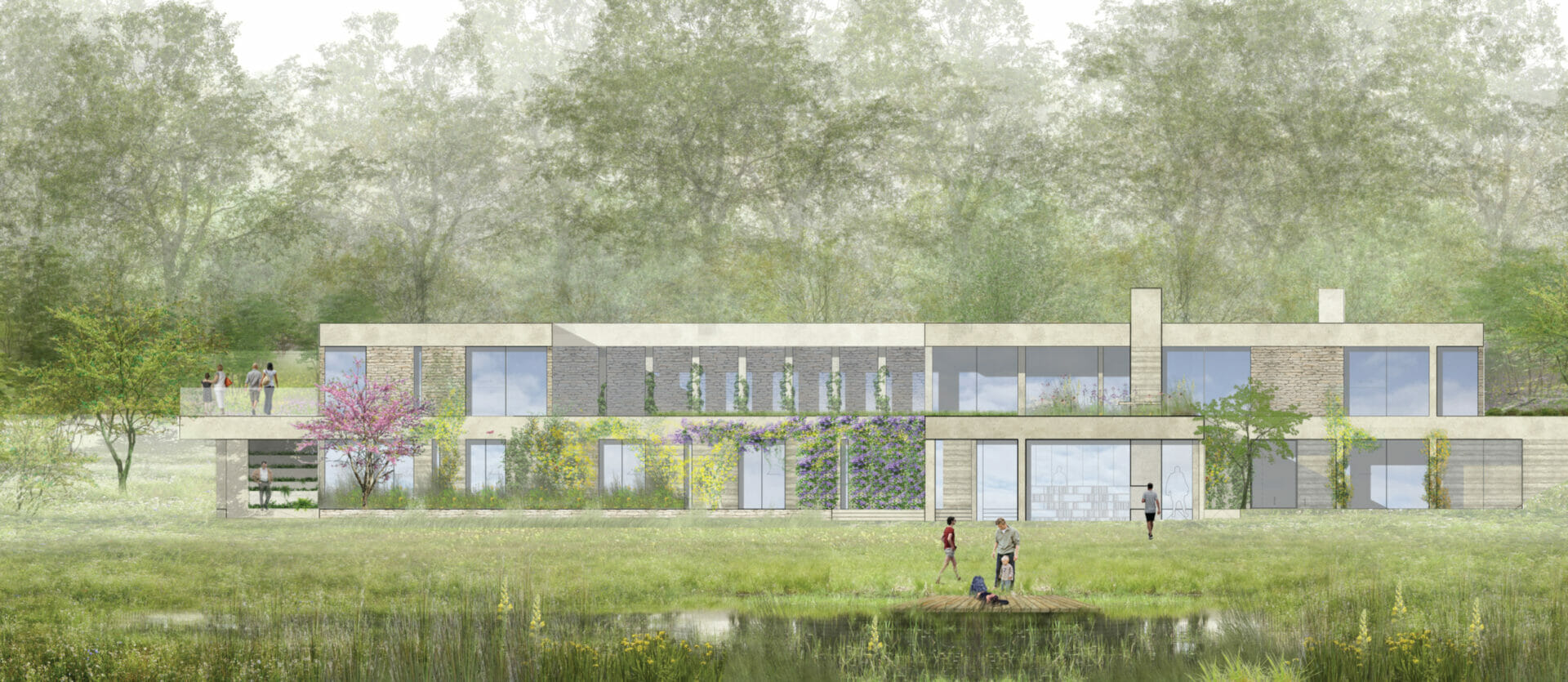
Field House is a substantial and stunning new private home set in the Cotswolds The client brief was for a ‘modern country house’ and the scheme offers a 21st century vision of a traditional country house and its landscape. The avoidance of thermal bridging at various points in the design detailing was extremely important and the Schöck Isokorb, along with the new Schöck Sconnex product, are incorporated to provide the necessary insulation solutions.
The Field House scheme is located on grassland used for animal stabling and creates a unique, site specific dwelling. Special consent was sought through the National Planning Policy Framework, which allows certain new homes to be built in the countryside and, as in this case, Areas of Outstanding National Beauty. Historically country houses tended to impose themselves on the landscape, but Field House is sensitively designed, becoming part of the landscape, rather than an imposition on it. In addition to integrating with the landscaping, other traditional themes that have been reinterpreted as part of the modern design proposals are the arrival forecourt; the gate house; the principal courtyard and the stepped garden terraces. Also, what in an earlier century would have been gardens or an idealised landscape, the design here forms a real environment providing habitats for wildlife, especially endangered species, to flourish. The main living space of the house contains a feature rammed earth wall that supports the concrete roof terrace structure above. The external walls of the house are constructed from rammed concrete, a dry concrete mix that is compacted between shutters. Sustainability was important and the engineers worked closely with the architect to reduce the embodied carbon in the house by refining the carbon heavy parts of the structure. For example by adding in an additional column to reduce the floor slab thickness by 100mm; and specifying a concrete mix that reduced the embodied carbon.


The avoidance of thermal bridging was critical
Special consideration had to be given to the avoidance of thermal bridging, particularly with the parapets and columns. The architecture and structure of Field House are closely integrated and as a result there was a high degree of collaboration between Bath and London based Integral Engineering Design and South Wales based Loyn+Co Architects. James Stroud, a director at Loyn+Co comments: “Minimising the risk of thermal bridging at critical connectivity areas throughout was an important consideration. We had no doubts that the Schöck product solutions used would exceed the performance requirements. As a result we incorporated the Isokorb XT type A as parapet thermal breaks and the Sconnex type W where columns needed to be thermally broken”.
The Schöck Isokorb as parapet thermal breaks
Parapets allow conductive materials to transfer energy through the thermal barrier and are therefore just as prone to the problems of thermal bridging as balconies. In the majority of cases, the conventional method of insulating parapets is to wrap the perimeter of the wall with an insulation barrier. However, the Schöck Isokorb XT type A offers an altogether more thermally efficient and cost-effective alternative. It permits a more sophisticated construction opportunity for greater freedom of design, allows flexible distance between elements according to load requirements, is extremely durable and impermeable to water – so no maintenance is required. The 120 mm insulation thickness of the XT type A significantly reduces heat loss, also the product is assessed as a ‘Certified Passive House Component’, provides BBA Certification, LABC Registration and NHBC approval – while meeting full compliance with the relevant UK building regulations.


The new Schöck solution for reinforced concrete walls
The recently introduced Schöck Sconnex type W minimises the thermal bridge between the exterior wall insulation and the insulation above the floor slab. Around 40% of all thermal bridges in a building are caused by walls and supports, which in turn are responsible for about 10% of heating energy losses. The Schöck solution offers an application-friendly, high-quality solution. Heating costs are lower, a pleasant room climate is created and the linear thermal transmittance (Psi) of the connected reinforced concrete wall is reduced by up to 90 percent. This outstanding insulation performance is combined with an excellent load-bearing capacity, which transmits very high pressure, tensile and shear forces in the longitudinal and transverse direction. This is made possible by the use of a pressure buffer consisting of ultra-high performance fibre reinforced concrete, which achieves compressive strength in excess of 175 N/mm2 – but with extremely good flexural strength as well. There is also a significant cost reduction involved when compared to installing insulation beneath the floor slab.
For full information on the entire range of Schöck structural building components contact the company on 01865 290 890; or visit the website at www.schoeck.com
